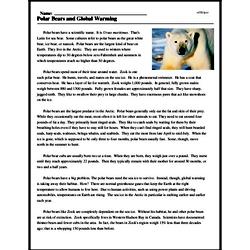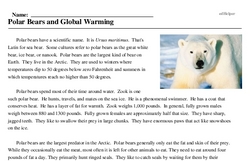Polar Bears and Global Warming
Polar bears have a scientific name. It is Ursus maritimus. That's Latin for sea bear. Some cultures refer to polar bears as the great white bear, ice bear, or nanook. Polar bears are the largest kind of bear on Earth. They live in the Arctic. They are used to winters where temperatures dip to 50 degrees below zero Fahrenheit and summers in which temperatures reach no higher than 50 degrees.
Polar bears spend most of their time around water. Zook is one such polar bear. He hunts, travels, and mates on the sea ice. He is a phenomenal swimmer. He has a coat that conserves heat. He has a layer of fat for warmth. Zook weighs 1,000 pounds. In general, fully grown males weigh between 880 and 1300 pounds. Fully grown females are approximately half that size. They have sharp, jagged teeth. They like to swallow their prey in large chunks. They have enormous paws that act like snowshoes on the ice.
Polar bears are the largest predator in the Arctic. Polar bears generally only eat the fat and skin of their prey. While they occasionally eat the meat, most often it is left for other animals to eat. They need to eat around four pounds of fat a day. They primarily hunt ringed seals. They like to catch seals by waiting for them by their breathing holes even if they have to stay still for hours. When they can't find ringed seals, they will hunt bearded seals, harp seals, walruses, beluga whales, and seabirds. They eat the most from late April to mid-July. When the ice is gone, which is supposed to be only three to four months, polar bears usually fast. Some, though, move north in the summer to hunt.




